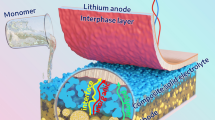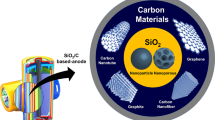Abstract
Lithium-sulfur (Li-S) batteries have gained widespread attention owing to their high theoretical energy density and low cost. However, the commercial application of these batteries is hindered by the severe shuttle effect and slow redox reaction kinetics of polysulfides. In this study, a hierarchically porous membrane consisting of CoSe2 nanoparticle-decorated carbon nanofibers containing carbon nanotubes (CoSe2@CNF/CNT) is constructed as a self-supported sulfur host for Li-S batteries. The hierarchical conductive network of CNFs/CNTs with N-doped porous carbon facilitates electron/ion transport and provides sufficient space to mitigate the volume expansion of lithium polysulfides (LiPSs). Moreover, the modified CoSe2 nanoparticles serve as both chemical trappers and electrocatalysts, chemically anchoring LiPSs and accelerating the redox kinetics to inhibit the shuttle effect. As a result, an initial specific discharge capacity of 1098.8 mA h g−1 is achieved at 1 C. Importantly, the cathode exhibits superior cycling stability with a capacity decay rate as low as 0.06% over 500 cycles. This work offers a feasible approach to designing multi-functional sulfur hosts for high-energy-density Li-S batteries.

摘要
具有高理论容量和高能量密度的锂硫电池被认为是最具前景的储能器件, 但其实用化进程受到了多硫化物穿梭效应和氧化还原动力学缓慢等问题的影响. 本文将CoSe2纳米颗粒修饰的碳纳米纤维/碳纳米管(CoSe2@CNF/CNT)自支撑膜作为高性能锂硫电池硫宿主电极. 其中, 由氮掺杂多孔碳和CNF/CNT组成的导电碳网络能够促进电荷传输,并缓解硫在循环过程中的体积膨胀. CoSe2纳米颗粒兼具化学吸附位点和电催化剂的功能, 通过化学吸附锚定多硫化物并加速其氧化还原转换, 从而抑制穿梭效应和提高性能. 因此CoSe2@CNF/CNT-S电极具有优异的电化学性能, 1 C下能提供1098.8 mA h g−1的放电比容量, 循环500圈中每圈容量衰减率低至0.06%. 这项工作为高能量密度锂硫电池的开发提供了一种新方案.
Similar content being viewed by others
References
Seh ZW, Sun Y, Zhang Q, et al. Designing high-energy lithium-sulfur batteries. Chem Soc Rev, 2016, 45: 5605–5634
Chen ZX, Zhao M, Hou LP, et al. Toward practical high-energy-density lithium-sulfur pouch cells: A review. Adv Mater, 2022, 34: 2201555
Rana M, Ahad SA, Li M, et al. Review on areal capacities and long-term cycling performances of lithium sulfur battery at high sulfur loading. Energy Storage Mater, 2019, 18: 289–310
Chung SH, Manthiram A. Current status and future prospects of metal-sulfur batteries. Adv Mater, 2019, 31: 1901125
Li Y, Guo S. Material design and structure optimization for rechargeable lithium-sulfur batteries. Matter, 2021, 4: 1142–1188
Li J, Niu Z, Guo C, et al. Catalyzing the polysulfide conversion for promoting lithium sulfur battery performances: A review. J Energy Chem, 2021, 54: 434–451
Li Y, Zhou Y, Muhammad Y, et al. Nanocellulose and its derivatives toward advanced lithium sulfur batteries. ACS Mater Lett, 2021, 3: 1130–1142
Yang Y, Cao J, Li W, et al. Ultrahigh-capacity and dendrite-free lithium metal anodes enabled by lithiophilic bimetallic oxides. J Mater Chem A, 2022, 10: 23896–23904
Deng R, Ke B, Xie Y, et al. All-solid-state thin-film lithium-sulfur batteries. Nano-Micro Lett, 2023, 15: 73
Hu G, Xu C, Sun Z, et al. 3D graphene-foam-reduced-graphene-oxide hybrid nested hierarchical networks for high-performance Li-S batteries. Adv Mater, 2016, 28: 1603–1609
Xie Y, Cao J, Wang X, et al. MOF-derived bifunctional Co0.85Se nanoparticles embedded in N-doped carbon nanosheet arrays as efficient sulfur hosts for lithium-sulfur batteries. Nano Lett, 2021, 21: 8579–8586
Pu X, Yang G, Yu C. Liquid-type cathode enabled by 3D sponge-like carbon nanotubes for high energy density and long cycling life of Li-S batteries. Adv Mater, 2014, 26: 7456–7461
Liu H, Liu X, Li W, et al. Porous carbon composites for next generation rechargeable lithium batteries. Adv Energy Mater, 2017, 7: 1700283
Zheng M, Chi Y, Hu Q, et al. Carbon nanotube-based materials for lithium-sulfur batteries. J Mater Chem A, 2019, 7: 17204–17241
Lin L, Pei F, Peng J, et al. Fiber network composed of interconnected yolk-shell carbon nanospheres for high-performance lithium-sulfur batteries. Nano Energy, 2018, 54: 50–58
Wang M, Zhou X, Cai X, et al. Hierarchically porous, ultrathin N-doped carbon nanosheets embedded with highly dispersed cobalt nanoparticles as efficient sulfur host for stable lithium-sulfur batteries. J Energy Chem, 2020, 50: 106–114
Cheng Q, Yin Z, Pan S, et al. Enhancing adsorption and reaction kinetics of polysulfides using CoP-coated N-doped mesoporous carbon for high-energy-density lithium-sulfur batteries. ACS Appl Mater Interfaces, 2020, 12: 43844–43853
Liu J, Xiao S, Liu X, et al. Encapsulating Co9S8 nanocrystals into CNT-reinforced N-doped carbon nanofibers as a chainmail-like electrocatalyst for advanced Li-S batteries with high sulfur loading. Chem Eng J, 2021, 423: 130246
Li T, Liu K, Wang S, et al. Mesoporous hierarchical NiCoSe2–NiO composite self-supported on carbon nanoarrays as synergistic electrocatalyst for flexible lithium-sulfur batteries. J Colloid Interface Sci, 2022, 629: 114–124
Fang Y, Yu XY, Lou XWD. Formation of hierarchical Cu-doped CoSe2 microboxes via sequential ion exchange for high-performance sodium-ion batteries. Adv Mater, 2018, 30: 1706668
Yang D, Zhang C, Biendicho JJ, et al. ZnSe/N-doped carbon nanoreactor with multiple adsorption sites for stable lithium-sulfur batteries. ACS Nano, 2020, 14: 15492–15504
Ye Z, Jiang Y, Li L, et al. A high-efficiency CoSe electrocatalyst with hierarchical porous polyhedron nanoarchitecture for accelerating polysulfides conversion in Li-S batteries. Adv Mater, 2020, 32: 2002168
Xiang M, Wu H, Liu H, et al. A flexible 3D multifunctional MgO-decorated carbon foam@CNTs hybrid as self-supported cathode for high-performance lithium-sulfur batteries. Adv Funct Mater, 2017, 27: 1702573
Yun X, Lu T, Zhou R, et al. Heterostructured NiSe2/CoSe2 hollow microspheres as battery-type cathode for hybrid supercapacitors: Electrochemical kinetics and energy storage mechanism. Chem Eng J, 2021, 426: 131328
Cao J, Xie Y, Yang Y, et al. Achieving uniform Li plating/stripping at ultrahigh currents and capacities by optimizing 3D nucleation sites and Li2Se-enriched SEI. Adv Sci, 2022, 9: 2104689
Wu J, Pan Z, Zhang Y, et al. The recent progress of nitrogen-doped carbon nanomaterials for electrochemical batteries. J Mater Chem A, 2018, 6: 12932–12944
Wu ZS, Ren W, Xu L, et al. Doped graphene sheets as anode materials with superhigh rate and large capacity for lithium ion batteries. ACS Nano, 2011, 5: 5463–5471
Su H, Lu L, Yang M, et al. Decorating CoSe2 on N-doped carbon nanotubes as catalysts and efficient polysulfides traps for Li-S batteries. Chem Eng J, 2022, 429: 132167
Wang M, Fan L, Sun X, et al. Nitrogen-doped CoSe2 as a bifunctional catalyst for high areal capacity and lean electrolyte of Li-S battery. ACS Energy Lett, 2020, 5: 3041–3050
Zhu J, Pitcheri R, Kang T, et al. Electrospun carbon nanofibers decorated with MnO nanoparticles as a sulfur-absorbent for lithium-sulfur batteries. Ceramics Int, 2018, 44: 16837–16843
Wong H, Ou X, Zhuang M, et al. Selenium edge as a selective anchoring site for lithium-sulfur batteries with MoSe2/graphene-based cathodes. ACS Appl Mater Interfaces, 2019, 11: 19986–19993
Mao Y, Li G, Guo Y, et al. Foldable interpenetrated metal-organic frameworks/carbon nanotubes thin film for lithium-sulfur batteries. Nat Commun, 2017, 8: 14628
Su D, Cortie M, Wang G. Fabrication of N-doped graphene-carbon nanotube hybrids from Prussian blue for lithium-sulfur batteries. Adv Energy Mater, 2017, 7: 1602014
Cao Z, Wang Y, Guo J, et al. CoSe-catalyzed growth of graphene sheath to construct CNF@graphene-CoSe cable/sheath heterostructure for high-performance lithium-sulfur batteries. Carbon, 2023, 204: 102–111
Zhang F, Wang H, Ji S, et al. Catalytically active CoSe2 supported on nitrogen-doped three dimensional porous carbon as a cathode for highly stable lithium-sulfur battery. ChemPhysChem, 2022, 23: e202100811
Cao Y, Lei F, Li Y, et al. Interface engineering in NiSe2/Ni2Co/CoSe2 heterostructures encapsulated in hollow carbon shells for high-rate Li-Se batteries. Nanoscale, 2022, 14: 13227–13235
Huang T, Sun Y, Wu J, et al. A dual-functional fibrous skeleton implanted with single-atomic Co-N dispersions for longevous Li-S full batteries. ACS Nano, 2021, 15: 14105–14115
Zhang H, Xin S, Li J, et al. Synergistic regulation of polysulfides immobilization and conversion by MOF-derived CoP-HNC nanocages for high-performance lithium-sulfur batteries. Nano Energy, 2021, 85: 106011
Xu J, Xu L, Zhang Z, et al. Heterostructure ZnSe–CoSe2 embedded with yolk-shell conductive dodecahedral as two-in-one hosts for cathode and anode protection of lithium-sulfur full batteries. Energy Storage Mater, 2022, 47: 223–234
Feng T, Zhao T, Zhu S, et al. Anion-doped cobalt selenide with porous architecture for high-rate and flexible lithium-sulfur batteries. Small Methods, 2021, 5: 2100649
Cai D, Liu B, Zhu D, et al. Ultrafine Co3Se4 nanoparticles in nitrogen-doped 3D carbon matrix for high-stable and long-cycle-life lithium sulfur batteries. Adv Energy Mater, 2020, 10: 1904273
Jin B, Yang L, Zhang J, et al. Bioinspired binders actively controlling ion migration and accommodating volume change in high sulfur loading lithium-sulfur batteries. Adv Energy Mater, 2019, 9: 1902938
Lieu WY, Fang D, Li Y, et al. Spherical templating of CoSe2 nanoparticle-decorated MXenes for lithium-sulfur batteries. Nano Lett, 2022, 22: 8679–8687
Qiu Y, Yin XJ, Wang MX, et al. Constructed conductive CoSe2 nanoarrays as efficient electrocatalyst for high-performance Li-S battery. Rare Met, 2021, 40: 3147–3155
He L, Yang D, Zhao H, et al. Bipolar CoSe2 nanocrystals embedded in porous carbon nanocages as an efficient electrocatalyst for Li-S batteries. Chem Eng J, 2022, 440: 135820
Acknowledgements
This work was supported by the National Natural Science Foundation of China (U22A20118), Fujian Science & Technology Innovation Laboratory for Optoelectronic Information of China (2021ZR146 and 2021ZZ122), and the Award Program for Fujian Minjiang Scholar Professorship. We would also like to thank Shuting Ren from Shiyanjia Lab (www.shiyanjia.com) for carrying out the XPS analyses.
Author information
Authors and Affiliations
Contributions
Wang X supervised the whole project. Ao J, Xie Y, and Wang X conceived the concept and initiated the project. Ao J and Xie Y designed and conducted the experiments and drafted the manuscript. All authors participated in the discussion of the results and revision of the manuscript.
Corresponding author
Additional information
Supplementary information
Supporting data are available in the online version of the paper.
Conflict of interest
The authors declare that they have no conflict of interest.
Juan Ao received her BSc degree from Yanshan University in 2019. Now she is an MSc student at the College of Physics and Information Engineering, Fuzhou University. Her current research focuses on the design of novel sulfur cathode for high performance lithium-sulfur batteries.
Yonghui Xie is a PhD candidate at the School of Physics and Information Engineering, Fuzhou University, focusing on the design and performance control of electrode materials for high energy density lithium-sulfur batteries.
Xinghui Wang completed his PhD degree in condensed matter physics from Lanzhou University in 2013, and then worked as a research staff at Nanyang Technological University and Singapore-MIT Alliance for Research and Technology in sequence. He is currently a Minjiang Scholar Professor at the College of Physics and Information Engineering, Fuzhou University. His research interests involve the fabrication of nanomaterials and thin film electrodes for energy storage application, mainly including thin film microbatteries, planar supercapacitors, flexible energy storage devices, lithium metal anodes, and sulfur cathodes.
Supporting Information
40843_2022_2462_MOESM1_ESM.pdf
CoSe2 Nanoparticles-decorated Carbon Nanofibers as A Hierarchical Self-supported Sulfur Host for high-energy lithium-sulfur batteries
Rights and permissions
About this article
Cite this article
Ao, J., Xie, Y., Lai, Y. et al. CoSe2 nanoparticles-decorated carbon nanofibers as a hierarchical self-supported sulfur host for high-energy lithium-sulfur batteries. Sci. China Mater. 66, 3075–3083 (2023). https://doi.org/10.1007/s40843-022-2462-x
Received:
Accepted:
Published:
Issue Date:
DOI: https://doi.org/10.1007/s40843-022-2462-x




